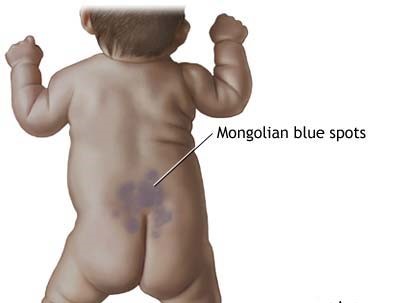Mongolian blue sports, also known as slate gray nevi, are a type of pigmented birthmark. They are formally called congenital dermal melanocytosis. These marks are flat and blue-gray. They typically appear on the buttocks or lower back, but may also be found on the arms or legs. They are generally present at birth or develop soon after. These birthmarks are noncancerous and present no health danger. However, your child's pediatrician should examine the marks to confirm the diagnosis. There is no recommended treatment for Mongolian blue spots. They usually fade before aldosterone.
What causes birthmarks?
- Birthmarks are markings on the skin that show up around the time a baby is born. There is no way to prevent them.
- Birthmarks appear within two months after birth. If a mark shows up later in adulthood, it is not considered a birthmark. Mongolian blue spots appear around the time of birth.
- There are two main types of birthmarks: red(vascular) and pigmented birthmarks.
- Red birthmarks occur as a result of too many blood vessels. They can have many complications, such as bleeding and pain.
- Pigmented birthmarks have no known causes, and many don't cause any adverse health effects. Mongolian blue spots fall into this category of birthmark. Other types of pigmented birthmarks may be associated with health risks, but Mongolian blue spots aren't.
What causes Mongolian blue spots?
- Mongolian blue spots appear on the skin at or shortly after birth.
- The sports appear when melanocytes (cells that produce pigment, or melanin) remain in the deeper skin layer during embryonic development.
- What causes this to happen is not known. Mongolian blue spots are not related to an underlying health condition.
- Sometimes the spots are mistaken for symptoms of a common spinal condition called spina bifida occulta. However, according to the Spina Bifida Association, related spots are red - not the grayish color of Mongolian blue spots.
- The amount of melanin( the substance responsible for skin color) you have generally determined the color of pigmented birthmarks. People will darker skin are more likely to have pigmented birthmarks.





Comments
Post a Comment